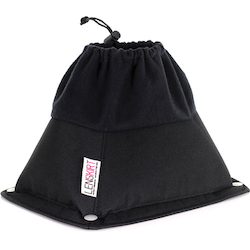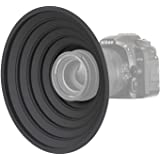Any camera can capture the needed scenery for vision and interaction, but other factors might limit the selection criteria:
- Field of view: Most cameras come with fixed optics that might not capture enough of the scene.
- Distance from the camera location to the processing PC: You might have the screen on one end of the store and the PC at the other end in a server room.
- Presence of screens: The PC might be set up behind the LED screen generating light and heat.
- Power availability: The location for the camera does not have easy access to power.
- Space availabilty: The available space might require a smaller camera, mounts, etc.
- Presence of obstacles: From glass to decorations, columns, walls, etc.
- Cabling space: Not enough space to route cables.
- Latency: Some solutions require hard real-time video feeds for interaction.
Camera options
USB Webcams
- Pros:
- The most affordable and simple option.
- Great variety.
- Some models have interchangeable optics.
- Cons:
- Limited USB cord length without amplification.
USB3+ Cameras
In case of USB 3+ cameras the USB cable should not exceed 1.5m and be of good quality, and has to be connected to a USB3.x port on the NUC or poor performance is to be expected.
Good quality USB3 extension cables with repeater can be used to extend the range.
Be cautioned though that there is much variability in cable quality.
Check the Intel Realsense guide about it at
Remote Managed USB Hubs
Some USB Cameras tend to fail and hang from time to time. It is recommended to install a remotely manageable USB 3.1 HUB like the Pegasus Astro. This HUB can cut power and data lines via software and fully reset the camera without needing presence.


USB over RJ45
- PROS: Use “any” webcam.
- CONS: HD/4k is expensive, needs USB 3.1 support.
- USB3.1 ~ 1500€ (+cable, +camera, etc, iCron)
- USB2 from 80€ to 455€ (e.g. iCron USB Ranger 2304)
USB Webcam + network encoder (Raspberry, specific…)
Another option is to plug the camera to a small device (Raspberry Pi, NUC, …) with network connectivity (wired or wireless). You can then use a server software to send the video stream over the network.
The caveat is that this will add some latency to the video stream. It might be better suited for analytics applications than hard real-time interaction.
There is also a “Commercial” version from AXIS (~300€):
Video Surveillance Cameras
Not the cheapest, but very affordable. Quality might vary. It is almost equivalent, in general, to using a USB webcam + raspberry (see previous section), but might add some useful features to the mix, such as:
- Smaller footprint.
- Simplified installation.
- Support for Power-over-ethernet, using a single cable for power and data.
- Reuse available security camera feeds.
On the other hand:
- Should support MJPEG streams for low latency apps
- Migh be offputting due to social issues.
Example:
| Item | Qty | PriceU |
|---|---|---|
| Dahua Domo POE | 1 | 180€ |
| Cable Ethernet 30m | 1 | 20€ |
| PFT1200 adaptador e inyector de PoE Gigabit Ethernet | 1 | 40€ |
SDI Cameras (Coaxial)
- PROS: Distance +100m over coaxial, almost no delay.
- CONS: Capture card on PC side, less camera options.
Providers
Mokose, cameras, UVC capture card.
Example:
- Camera ~100$:
- Capture Card~200$:
- Or AVerMedia Capture ~ 180€:
- Coaxial cable, 30m: ~60€
HDMI Cameras (over Cat6)
(In review)
Camera Optics and Placement
The camera is to be mounted using a ¼” screw adapter or similar around the screen, pointing towards the viewers.
Different camera apertures will focus on different areas and depths:
For camera setup depending on the installation and content setup you can use a tool like: CCTV Lens Calculator

Camera Orientation
Depending on the screen orientation (vertical vs portrait) the camera might be set up rotated 90º to acquire a larger photographic area. The image will arrive rotated to the PC software, and will have to be corrected later via software.
Camera Lenses
Most USB webcams come with fixed optics, that is the lenses are suited for a single use-case, usually short distance videoconference. Other come with replaceable lenses.
The most common lens mounts for webcams and CCTV are:
- CS Mount, usual in CCTVs.
- M12 Mount (or S mount) for smaller webcams.
Note that the quality of the lenses can greatly affect the quality of the image capture.
USB Webcams
- Logitech Brio 4k (fixed optics, FOV Diagonal: 90°/Horizontal:
- 82.1°/Vertical: 52.2°
- f/2.0,
- ~159€
- ELP
- Has different CCDs (e.g. Sony IMX214, 13MP, CS mount, 111$)
- Has CS and M5 lens mounts, allowing for interchangeable optics.
- Mokose (Sony IMX274, 4k, CS mount, 105$):
- Arducam (Sony IMX477, CS Mount, 149$):
USB 3D Cameras
- Orbbec Astra: 150$
- Intel RealSense:
- D415: 185$
- D455: 273$
- Azure Kinect DK: 399$
SDI Cameras
- Mokose HD, CS Mount, 89$
Accessories
Lens Skirt (for behind glass setups)
- Approx ~30-50$ From BH



